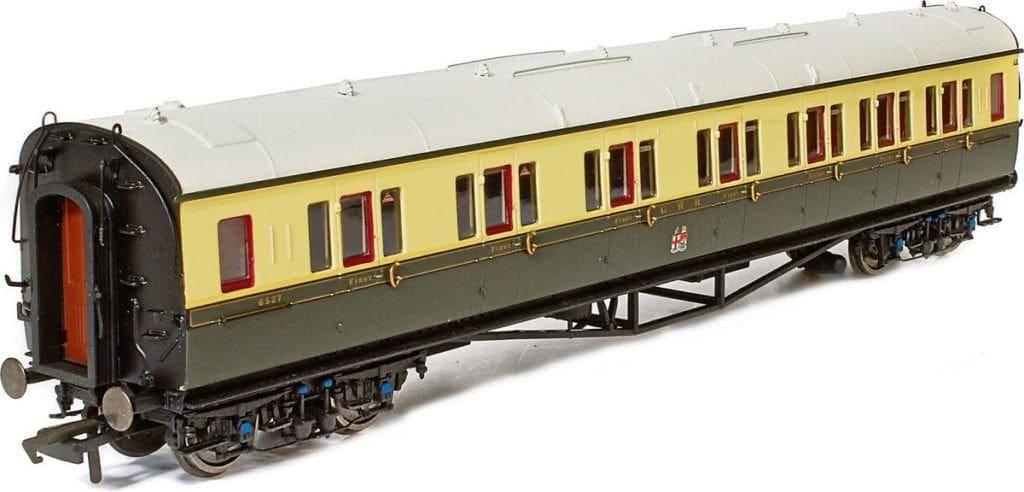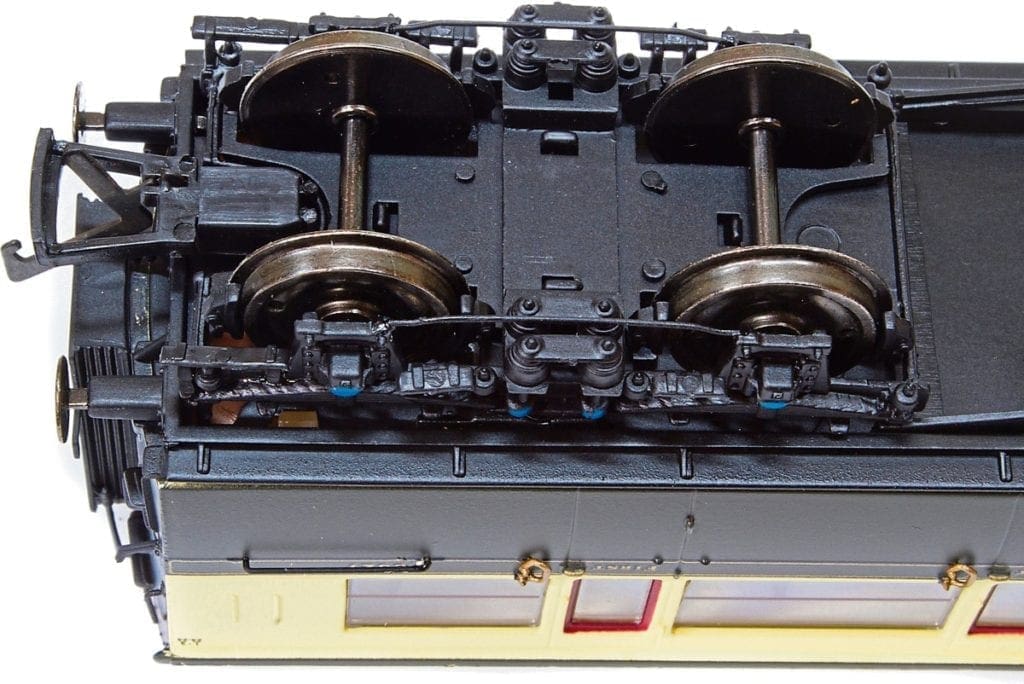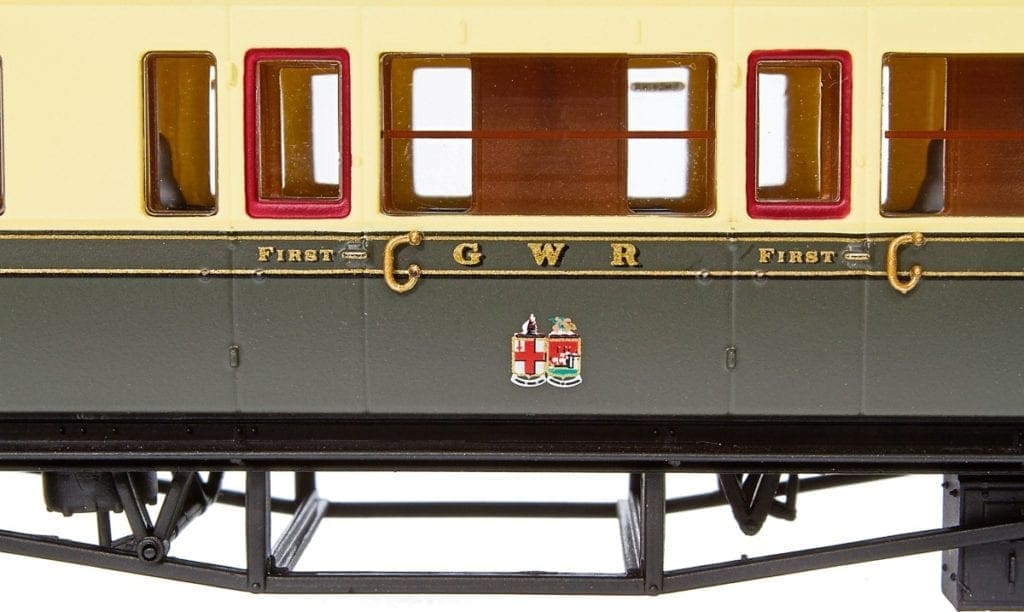Hornby’s popular OO-gauge Collett bow-ended corridor stock makes a welcome return finished in classic GWR livery, writes Nigel Burkin.

Collett’s bow-ended corridor stock became a standard for the Great Western Railway after 1925 when large numbers of the coaches were built at Swindon works at the rate, sometimes, of one coach every two to three days.
Construction consisted of steel panelling fitted over an oak wood frame mounted on a strong steel underframe, a design that would not meet the crash-worthiness requirements of the modern railway but was considered modern compared to the ageing ‘toplight’ stock! Collett introduced bow ends to shorten the length of gangways, making transfer from one coach to another more comfortable for passengers.
Bow ends continued to feature in the design of British coaching stock, including Mks.2, 3 and 4. Only in recent times have flat ends made a return with some modern designs.
The underframe was fitted with 7ft wheelbase single bolster bogies and external trussing.

Vacuum brake equipment and dynamo were fitted to the underframe alongside the appropriate rodding to reach the brake blocks on the bogies. Buck-eye couplings were also catered for in the design, making Charles Collett’s bow-ended 57ft coaches both clean in appearance and among the most modern coaches to operate on the GWR, becoming the de facto standard design.
It was so successful that many Collett coaches survived to see service with BR as late as the 1950s and 1960s, with some being allocated to departmental use long after they were withdrawn from mainline service. It is the retention of Collett coaches for departmental use that enabled preservationists to secure them, even though interiors had been extensively altered.
Hornby has an excellent article on its website detailing how it researched and developed the models with the assistance of the Didcot Railway Centre and other organisations. The result is a fine-looking collection of models which includes Corridor Brake Third stock in both ‘left-hand’ and ‘right hand’ (LH and RH) formats. A Corridor Third and two Corridor Composite, both LH and RH, coaches are included in the current batch of models, which are neatly dressed in GWR chocolate and cream livery with white roofs and black ends.

They impress as soon as they are removed from the box, sharing the same high level of specification as the recently released Collett bow-ended suburban coaches.
Coach body
Looking along the roofs and sides of the four review samples kindly submitted by Hornby for our critical appraisal, the injection-moulded plastic body shells are perfectly straight, with no signs of bowing along the rain gutter line or imperfections in the roofs. The sides are consistently modelled with the slight tumblehome at the base of the body, while the bow ends are also accurately represented and nicely fitted out with separate end gangways.
The slightly recessed windows of the type are fitted with clean and clear flush glazing. Window openings match the shape and size of the full-sized coaches compared with photographs and drawings. The window arrangement is correct for the LH and RH versions of the coaches, with a good view of the compartments and corridors visible though them.
Moulded detail is refined and subtle, yet clearly visible, including footsteps on the ends, roof seams, door hinges and lines, destination board brackets and toilet water tank hatches.
Underframe
There isn’t a great deal of detail fitted to the underframe of the mainline stock models considering the level of detail applied elsewhere. Some of the brake linkages are not modelled, but the vacuum cylinders, cross-rodding and V-hangers are neatly applied alongside battery boxes and a dynamo.
Headstocks, solebars and the floor itself are produced as a one-piece moulding and are equipped with the external truss rods and long footboards along the solebars. It is all neatly assembled and shows no sign of distortion. On the ends are sprung buffers with metalheads and coupling hooks.
Bogies, couplings and wheels
Lovely reproductions of the short 7ft single bolster wheelbase bogies have been fitted to this model and were chosen for the stock because they reduced wheel and flange wear yet performed well with a good ride.
Each bogie is a multiple-layered model in its own right, with a good level of moulded detail in the bogie frames including rivet, suspension springs, hangers and axle box detail. They feature a multiple-layer construction consisting of a number of components including tiny details such as the footsteps, spring planks, suspension springs themselves and brake shoes which are moulded in alignment with the wheels.

The wheels are composed of metal fitted to 26mm-long pinpoint axles and are of the correct diameter and pattern. They are fully concentric and run in inside bearings holes, producing free-rolling coaches with no sign of wobble either on the bogie pivots or the wheels themselves.
Couplings are of the standard tension-lock type fitted to NEM coupling pockets mounted in kinematic coupling cams which are mounted and neatly concealed at the ends of the underframe. There’s a curved slot in the leading spacer of the bogies to accommodate the coupling cam mechanism, and in the box, Hornby provides alternative continental-style couplings that could be used on the inside of a rake of coaches.
While the supplied tension lock couplings result in a wide gap between the gangways, use of alternative NEM-compliant couplings will close the gap up to a more realistic level. There is very little slack in the cams, allowing the coaches to negotiate second-radius curves with the cams working as they should avoid buffer and gangway lock.
Livery and finish
All four review models were beautifully and consistently finished with level lining, correct width cream bands down the sides of the coach and a pleasing semi-satin finish which is consistently applied. Colours appear to be accurate and match colour references and some GWR paint colours well.

Small painted details include brass applied to them individually moulded and fitted commode handles, door handles and red to the frames of droplight windows fitted to each door.
Printed detail is clear and sharp, including the classic GWR logo which in itself has several different colours. Gold lining, GWR legends and the class labels applied to each door are neatly printed, too. The coaches match perfectly when coupled together in a short rake with linear details such as rain gutters and the solebar footsteps lining up well when the stock is viewed down the length on a piece of straight and level track.
The construction quality of the models is excellent, with the numerous small details being attached firmly, including the separate roof ventilators, always slightly vulnerable compared to other models.

All details are coloured with the same consistent paint colours and level of finish, and particularly noteworthy in terms of finish, quality and durability are the bogies which, despite being composed of so many small components, are very strong and showed no signs of shedding details, including the tiny footstep details, during handling in the studio.
Hornby undoubtedly carries the gold standard for coaching stock models thanks to its recently developed and tooled steam-era models which are always well detailed, finished and assembled.
The Collett bow-ended corridor coaches are as good as one could desire for less than £50 per coach, which compares well with many wagon models that can touch similar prices yet are finished with less complex liveries and considerably fewer components applied to them.




